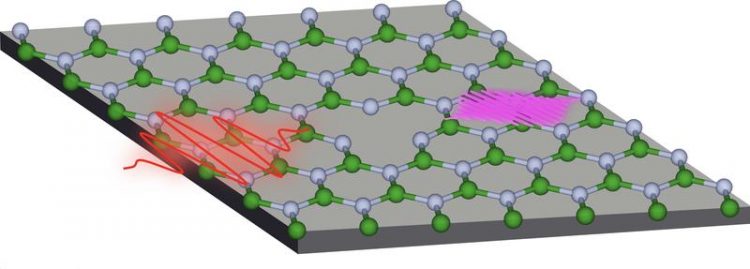A step towards controlling spin-dependent petahertz electronics by material defects

High-harmonic generation from a spin-polarized defect in hexagonal boron nitride M.S. Mrudul, Indian Institute of Technology, Bombay
Light waves perform several hundred trillion oscillations per second. Hence, it is natural to envision employing light oscillations to drive the electronic motion.
Unlike conventional techniques, light waves not only initiate the electronic motion but also control it on its natural timescale, i.e. the attosecond timescale (one attosecond is one quintillionth of a second). This has the potential to increase the operational speed of devices and computing by orders of magnitude and opens an avenue for petahertz electronics.
High-frequency flashes of light are emitted when a solid is exposed to intense ultrashort light. This process is known as high harmonic generation (HHG). The electric field oscillations of the incident light trigger and control the motion of electrons in solids, which sets the current in solids.
The induced current has two contributions: one from the transitions of electrons from valence bands to conduction bands and another due to the motion of electrons and holes in their respective energy bands.
In the theoretical and experimental studies of the process of HHG in solids, it is commonly assumed that the solids are defect-free. However, this underlying assumption is not true in practice. In real solids, defects are inevitable due to their growth processes. They can be of different forms such as vacancies, interstitials, or impurities.
At present, not much is known about how the presence of defects can modify the HHG process and associated electron dynamics. Keeping in mind that defect engineering has been the backbone of conventional optoelectronics, it is therefore crucial to understand the role of defects in the context of petahertz electronics and spintronics.
In their recent theoretical work published in npj Computational Materials, a team of researchers from the Indian Institute of Technology (IIT) in Bombay, India, and the Max-Planck Institute for the Structure and Dynamics of Matter (MPSD) in Hamburg, Germany, have addressed an important missing piece of information towards the endeavour of petahertz electronics and spintronics:
How do the different kinds of defects influence the motion of electrons in solids during HHG? To address this question, a two-dimensional monolayer of hexagonal boron nitride (h-BN) with a boron or a nitrogen atom vacancy is exposed to an intense light flash.
h-BN starts behaving as a donor or an acceptor of electrons as soon as a nitrogen or a boron atom is removed. This results in qualitatively different electronic structures and the induced vacancy defects become spin-polarized. In particular, the research team found that the two spin channels are affected differently and that electrons with opposite spins contribute differently to high-harmonic emission. Moreover, the electron-electron interaction manifests itself disparately in defected-solids in comparison to the pristine one.
The present work also anticipates the situation when either a nitrogen or a boron atom is replaced by a carbon atom (doping-defect) instead of removing the atom completely from h-BN. When a single boron atom is replaced by a single carbon atom, the electron dynamics resemble those where a nitrogen atom is removed completely from h-BN. Contrarily, the opposite situation arises when a nitrogen atom is replaced by a carbon atom: Here, the dynamics resemble those where a boron atom is completely detached from the system.
This work is a significant step towards achieving better control of light wave-driven petahertz spintronics using defect engineering in solids.
Prof. Gopal Dixit, lead author: gdixit@phy.iitb.ac.in
Dr. Nicolas Tancogne-Déjean, co-author: nicolas.tancogne-dejean@mpsd.mpg.de
Media Contact
All latest news from the category: Power and Electrical Engineering
This topic covers issues related to energy generation, conversion, transportation and consumption and how the industry is addressing the challenge of energy efficiency in general.
innovations-report provides in-depth and informative reports and articles on subjects ranging from wind energy, fuel cell technology, solar energy, geothermal energy, petroleum, gas, nuclear engineering, alternative energy and energy efficiency to fusion, hydrogen and superconductor technologies.
Newest articles

Magnetic tornado is stirring up the haze at Jupiter’s poles
Unusual magnetically driven vortices may be generating Earth-size concentrations of hydrocarbon haze. While Jupiter’s Great Red Spot has been a constant feature of the planet for centuries, University of California,…

Cause of common cancer immunotherapy side effect s
New insights into how checkpoint inhibitors affect the immune system could improve cancer treatment. A multinational collaboration co-led by the Garvan Institute of Medical Research has uncovered a potential explanation…

New tool makes quick health, environmental monitoring possible
University of Wisconsin–Madison biochemists have developed a new, efficient method that may give first responders, environmental monitoring groups, or even you, the ability to quickly detect harmful and health-relevant substances…



